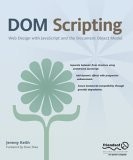Books for CSS web designers - Part 2
I wrote this post a while back. The content can still be relevant but the information I've linked to may not be available.
This is the second1 of a series of articles where I review books that are aimed at CSS web designers.
I know. DOM Scripting by Jeremy Keith is a book about JavaScript and the rather mysterious world of the Document Object Model (DOM). Why is it a book for CSS designers? Hang on, I'll explain.
Things have become a whole lot smarter in the JavaScript world
If you are like me, you may have used JavaScript in the 'old days' (circa 1998) to add a bit of frippery to your webpage. There were various browser detection methods and it all seemed a bit of a 'black art'. Since then, you may have used a Lightbox script here and a jQuery library there but never really understood it. However, about a year ago, it struck me that things have become a whole lot smarter in the JavaScript world. Just as CSS has been used to separate presentation from content, JavaScript can be used to separate webpage behavior from presentation and content. I think it may be time for the CSS designer to learn more!
In DOM Scripting, Jeremy Keith explains the background and how to get started with the use of JavaScript to manipulate your webpage. The book is aimed specifically at web designers. In my opinion, you cannot buy a better book if you are accustomed to the use of CSS but are new to JavaScript.
DOM Scripting
- Author: Jeremy Keith
- Paperback: 338 pages
- Publisher: APress (Sept 2005)
- ISBN: 1590595335
- Amazon UK Price: £15.83 (18-10-06)
This book is clearly written and each chapter is comprehensively explained. From A brief History of JavaScript and the DOM to a JavaScript image gallery, Creating Markup on the Fly, an Animated Slideshow, and a complete website. In particular, the explanations behind each coding step in the tutorials are excellent. It makes good sense to go through these in detail and it's something I would have valued a few years ago.
Every piece of code is analysed for best practice
The whole book strongly encourages best practices. You can almost hear the author saying "what other way is there?". For example, every piece of code is analysed for best practice ("Question everything") and the book provides good examples of graceful degradation (what happens if your users do not have JavaScript enabled) and unobtrusive JavaScript usage (separating the JavaScript code from the webpage structure).
The final chapter constructs a website called Jay Skript and the Domsters (punsville, don't give up your day job, Jeremy) and pulls it all together using examples from earlier in the book.
There is a DOM Scripting website and the author's online home is Adactio.com
If you are a coder by heart and have been using JavaScript for some time, then this book is probably not for you. A reference book may be a better choice. However, for the CSS designer who is new to JavaScript and wants to learn a bit more than just copy and pasting scripts into webpages, I strongly recommend this book.
» Buy the book from Amazon UK
1 Previously on this blog: Bulletproof Web Design


Comments are OFF for this post.